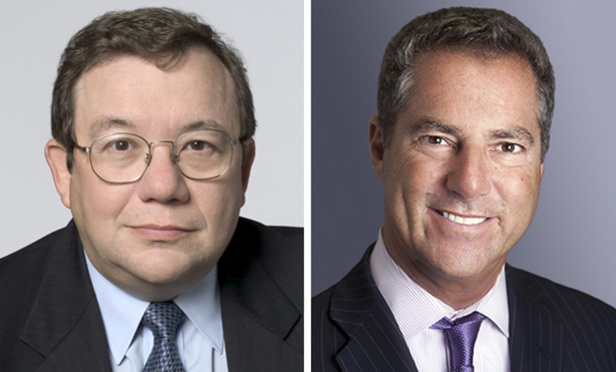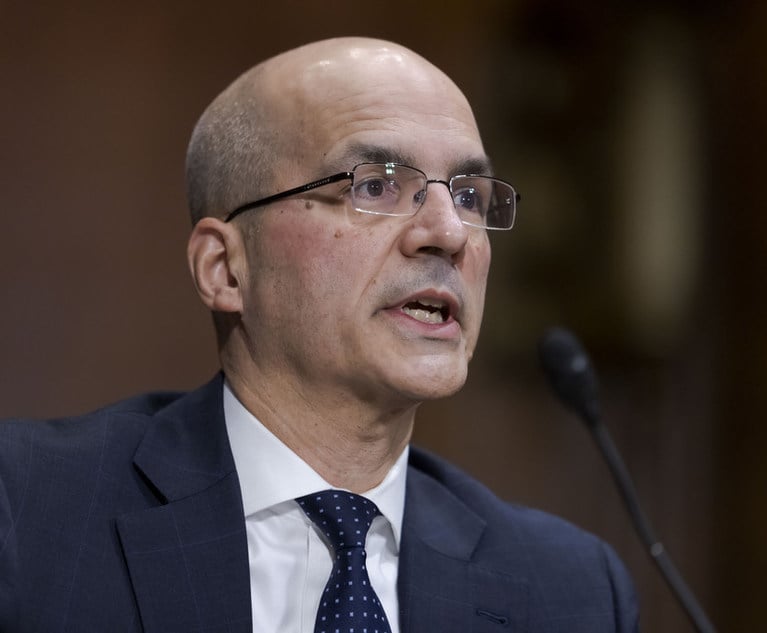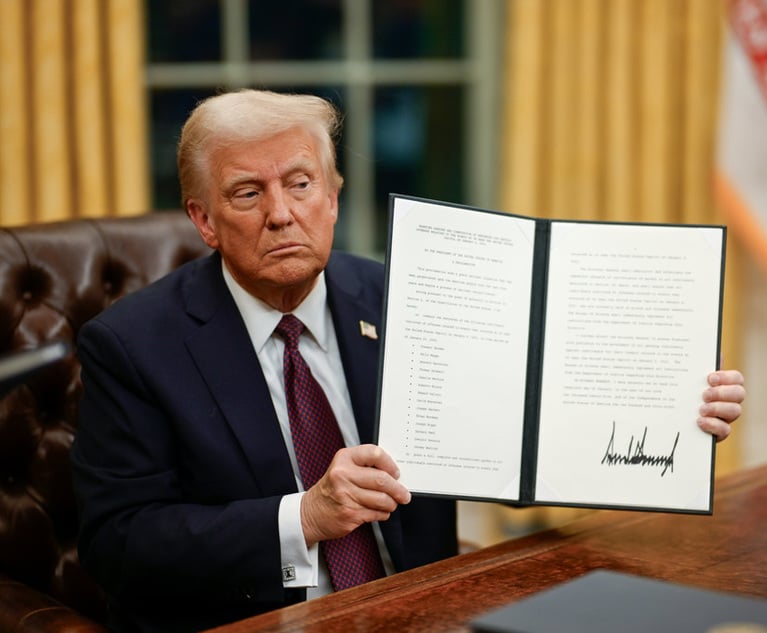Our 400th Column
In this Second Circuit Review, Martin Flumenbaum and Brad S. Karp reflect upon changes in the Second Circuit since their first column was published in 1985. They focus on the changing composition of the court's membership, shifts in the court's caseload, revisions to the Local Rules, and decisions and developments in the case law.
February 26, 2019 at 02:45 PM
8 minute read
 Martin Flumenbaum and Brad S. Karp
Martin Flumenbaum and Brad S. Karp
This month marks our 400th “Second Circuit Review” column. On this occasion, we reflect upon changes in the Second Circuit since our first column was published in 1985. We focus on the changing composition of the court's membership, shifts in the court's caseload, revisions to the Local Rules, and decisions and developments in the case law.
When we wrote our first column, Ronald Reagan had started his second term as President of the United States, he had cut taxes, the Dow Jones Industrial Average (DJIA) had recently closed at 1,475.69, Congress and the federal judiciary were predominantly white and male, and emails and the Internet were unimaginable. Today, President Trump has just begun the second half of his first term, has similarly passed tax cuts, and on Feb. 15, 2019 the DJIA closed at 25,883.25. The legislative and judicial branches, however, while still predominantly white and male, have grown more diverse, as exemplified by the new 116th Congress—the most diverse Congress ever sworn in.
The Court's Membership Reflects Growing Diversity
1985 and 1986 were important years for the Second Circuit's membership: Judges Robert J. Miner and J. Daniel Mahoney were appointed to the new 12th and 13th seats on the Second Circuit—the first expansion of the court since 1979. The remaining 11 active judges included Chief Judge Wilfred Feinberg and Judges Frank X. Altimari, Richard J. Cardamone, Irving R. Kaufman, Amalya L. Kearse, Thomas J. Meskill, Jon O. Newman, James L. Oakes, Lawrence W. Pierce, George C. Pratt, and Ralph K. Winter. As one might expect, the court, although filled with well-credentialed jurists, was predominantly white and male. In 1986, the active bench included only one female (Judge Kearse) and two minorities (Judges Kearse and Pierce).
Consistent with changes across the nation, the court today has a more diverse composition. Today's active judges include Chief Judge Robert A. Katzmann and Judges José A. Cabranes, Susan L. Carney, Denny Chin, Christopher F. Droney, Peter W. Hall, Dennis Jacobs, Debra Ann Livingston, Raymond J. Lohier Jr., Rosemary S. Pooler and Richard J. Sullivan. This includes three female judges (Judges Carney, Livingston and Pooler) and three minority judges (Judges Cabranes, Chin and Lohier Jr.). Two seats are vacant, with Judges Gerard E. Lynch and Reena Raggi assuming senior status in 2016 and 2018; President Trump has nominated Judge Joseph Bianco of the Eastern District of New York and Michael Park of Consovoy McCarthy Park to fill these vacancies.
Caseload
Since 1985, the Second Circuit's caseload has increased 43 percent (as of September 2018). And between November 1985 and February 2019, the Circuit published 14,800 decisions. The Circuit's busiest year was 2005, with a record 7,035 appeals filed, comprised of thousands of Board of Immigration Appeals (BIA) appeals. The Second Circuit shouldered 25 percent of all BIA appeals filed in 2004 and 2005.
To address the increase, the Second Circuit established the Non-Argument Calendar for all appeals challenging the BIA's denial of an asylum claim. Judge Jon O. Newman, “The Second Circuit's Expedited Adjudication of Asylum Cases: A Case Study of a Judicial Response to an Unprecedented Problem of Caseload Management,” 74 Brook. L. Rev. 429, 433 (2008). Under this new procedure, as many as 48 appeals were assigned to panels weekly, and appellants were not allowed oral argument. Id. at 434. Slowly, as the backlog of BIA appeals eased, the court's docket decreased accordingly. In September 2018, there were 4,062 appeals filed, of which only 694 were administrative appeals.
Local Rules Revamped
The Second Circuit's Local Rules also were changed significantly since 1985. In 2008, the Circuit revised its rules, including Local Rules (LR) 25.1, 27.1, and 31.2(b).
LR 25.1 mandated electronic filing in the Second Circuit, outlawing paper copies of every document except initiating documents, certain motions, and oversized documents. See Jodi Balsam, “The New Second Circuit Local Rules: Anatomy and Commentary,” 19 J.L. & Pol'y 469, 510 (2011). LR 25.1 further encourages electronic filing by requiring all admitted practitioners to register as a “Filing User” with PACER, thus consenting to electronic service of documents.
LR 27.1 also altered the court's procedures. Under the previous version of the rule, motions to extend the time to file a brief and motions to file oversized briefs comprised a large portion of briefs filed. Id. at 512. LR 27.1 now requires an “extraordinary circumstance” for a motion to extend the time to file a brief to be granted, and motions to filed oversized briefs are now expressly “[d]isfavored.” See Local Rule 27.1(e)(1) & (f)(1).
The Second Circuit's Expedited Appeals Calendar (XAC), the Circuit's reaction to the Supreme Court's heightening of pleading standards in Bell Atlantic Corporation v. Twombly, 550 U.S. 544 (2007) and Ashcroft v. Iqbal, 556 U.S. 662 (2009), was an innovative addition to the Local Rules. Judge Jon O. Newman, “The Second Circuit's Expedited Appeals Calendar for Threshold Dismissals,” 80 Brook. L. Rev. 429 (2015). This Rule places appeals from threshold dismissals by district courts on an expedited schedule that reduces each party's time to file its brief from 91 days to 35 days. Parties may request removal from the calendar; though, from Jan. 1, 2011 to June 30, 2014, only 23 of the 353 appeals placed on the XAC requested removal, indicating the bar's acceptance of the rule. Id. at 431.
Defining the Law
The Second Circuit's case law has also evolved. Most notably, the standard for surviving a motion to dismiss is much stricter. This includes the heightened pleading standard set by the Supreme Court's reversals of the Second Circuit in Twombly and Iqbal. Pleading standing for future or speculative harm is also more difficult under the Supreme Court's seminal decision Clapper v. Amnesty International USA, 568 U.S. 398 (2013). There, the Supreme Court rejected the Second Circuit's “objectively reasonable likelihood” standard as inconsistent with Article III's requirement that a threatened injury be impending. Id. at 410.
Civil securities fraud claims are more difficult to prosecute. In 1995, the Private Securities Litigation Reform Act (PSLRA) introduced the “strong inference” standard for pleading scienter, which raised the bar for plaintiffs seeking redress under the securities laws. The Second Circuit required this heightened standard before it was imposed by the PSLRA. Karen Patton Seymour, “Securities and Financial Regulation in the Second Circuit,” 85 Fordham L. Rev. 225, 239 (2016). By the time the PSLRA was enacted, the court had formed a robust test whereby plaintiffs could satisfy this standard by alleging that defendants had “the motive and opportunity to commit fraud” or “facts that constitute strong circumstantial evidence of conscious misbehavior or recklessness.” Shields v. Citytrust Bancorp, 25 F.3d 1124, 1128 (2d Cir. 1994). Overall, the PSLRA did not drastically affect the court's case law, as the Second Circuit continued using the test finding that the PSLRA did not “change the basic pleading standard for scienter in this circuit.” Novak v. Kasaks, 216 F.3d 300, 310 (2d Cir. 2000).
The Circuit has also limited application of Section 10(b) of the Exchange Act to extraterritorial conduct after the Supreme Court rejected its longstanding conduct and effects tests in Morrison v. National Australia Bank Ltd., 561 U.S. 247 (2010). Seymour, supra at 240. Under Morrison, civil suits brought under Section 10(b) must be based on a purchase or sale of a security listed on a U.S. exchange or on domestic transactions in other securities. In Parkcentral Global Hub Ltd. v. Porsche Automobile Holdings SE, 763 F.3d 198 (2d Cir. 2014), the Second Circuit limited Morrison, holding that a domestic transaction is a necessary element of a Section 10(b) claim, but not necessarily a sufficient one. Thus, under the court's new precedent, it is possible for securities transactions that have occurred in the U.S. to be insufficiently domestic to apply Section 10(b) liability.
Finally, the Second Circuit has been a trailblazer in affording greater protection against discrimination based on sexual orientation. In the landmark case Windsor v. United States, the Second Circuit held “that homosexuals compose a class that is subject to heightened scrutiny,” and, under intermediate scrutiny, Section 3 of the Defense of Marriage Act was unconstitutional. 699 F.3d 169, 185-88 (2d Cir. 2012). This was an important step forward and a notable change, as the Second Circuit had previously upheld the U.S. military's prohibition on homosexuals as constitutional under the less onerous rational basis review standard. See Able v. United States, 155 F.3d 628 (2d Cir. 1998). The Supreme Court ultimately affirmed the Second Circuit's decision, and Windsor was considered a watershed moment in the gay rights movement. This trend has continued: Just last year, the court held that Title VII prohibits employment discrimination based on sexual orientation. See Zarda v. Altitude Express, 883 F.3d 100 (2d Cir. 2018).
Conclusion
It has been an honor to cover a court that has been a leader among its fellow circuits. We look forward to the publication of our 500th column on June 23, 2027 and can only imagine the path the Circuit will mark as it strives to effect innovative and pragmatic justice.
Martin Flumenbaum and Brad S. Karp are litigation partners at Paul, Weiss, Rifkind, Wharton & Garrison, specializing in complex commercial and white-collar defense litigation. Mr. Karp is chair of the firm. J.T. Parker Murray, a litigation associate at the firm, assisted in the preparation of this column.
This content has been archived. It is available through our partners, LexisNexis® and Bloomberg Law.
To view this content, please continue to their sites.
Not a Lexis Subscriber?
Subscribe Now
Not a Bloomberg Law Subscriber?
Subscribe Now
NOT FOR REPRINT
© 2025 ALM Global, LLC, All Rights Reserved. Request academic re-use from www.copyright.com. All other uses, submit a request to [email protected]. For more information visit Asset & Logo Licensing.
You Might Like
View All
'A Shock to the System’: Some Government Attorneys Are Forced Out, While Others Weigh Job Options
7 minute read
'Serious Legal Errors'?: Rival League May Appeal Following Dismissal of Soccer Antitrust Case
6 minute read
How Some Elite Law Firms Are Growing Equity Partner Ranks Faster Than Others
4 minute read
Trending Stories
- 1NBA Players Association Finds Its New GC in Warriors Front Office
- 2Prenuptial Agreement Spousal Support Waivers: Proceed With Caution
- 3DC Circuit Keeps Docs in Judge Newman's Misconduct Proceedings Sealed
- 4Litigators of the Week: US Soccer and MLS Fend Off Claims They Conspired to Scuttle Rival League’s Prospect
- 5Litigator of the Week Runners-Up and Shout-Outs
Who Got The Work
J. Brugh Lower of Gibbons has entered an appearance for industrial equipment supplier Devco Corporation in a pending trademark infringement lawsuit. The suit, accusing the defendant of selling knock-off Graco products, was filed Dec. 18 in New Jersey District Court by Rivkin Radler on behalf of Graco Inc. and Graco Minnesota. The case, assigned to U.S. District Judge Zahid N. Quraishi, is 3:24-cv-11294, Graco Inc. et al v. Devco Corporation.
Who Got The Work
Rebecca Maller-Stein and Kent A. Yalowitz of Arnold & Porter Kaye Scholer have entered their appearances for Hanaco Venture Capital and its executives, Lior Prosor and David Frankel, in a pending securities lawsuit. The action, filed on Dec. 24 in New York Southern District Court by Zell, Aron & Co. on behalf of Goldeneye Advisors, accuses the defendants of negligently and fraudulently managing the plaintiff's $1 million investment. The case, assigned to U.S. District Judge Vernon S. Broderick, is 1:24-cv-09918, Goldeneye Advisors, LLC v. Hanaco Venture Capital, Ltd. et al.
Who Got The Work
Attorneys from A&O Shearman has stepped in as defense counsel for Toronto-Dominion Bank and other defendants in a pending securities class action. The suit, filed Dec. 11 in New York Southern District Court by Bleichmar Fonti & Auld, accuses the defendants of concealing the bank's 'pervasive' deficiencies in regards to its compliance with the Bank Secrecy Act and the quality of its anti-money laundering controls. The case, assigned to U.S. District Judge Arun Subramanian, is 1:24-cv-09445, Gonzalez v. The Toronto-Dominion Bank et al.
Who Got The Work
Crown Castle International, a Pennsylvania company providing shared communications infrastructure, has turned to Luke D. Wolf of Gordon Rees Scully Mansukhani to fend off a pending breach-of-contract lawsuit. The court action, filed Nov. 25 in Michigan Eastern District Court by Hooper Hathaway PC on behalf of The Town Residences LLC, accuses Crown Castle of failing to transfer approximately $30,000 in utility payments from T-Mobile in breach of a roof-top lease and assignment agreement. The case, assigned to U.S. District Judge Susan K. Declercq, is 2:24-cv-13131, The Town Residences LLC v. T-Mobile US, Inc. et al.
Who Got The Work
Wilfred P. Coronato and Daniel M. Schwartz of McCarter & English have stepped in as defense counsel to Electrolux Home Products Inc. in a pending product liability lawsuit. The court action, filed Nov. 26 in New York Eastern District Court by Poulos Lopiccolo PC and Nagel Rice LLP on behalf of David Stern, alleges that the defendant's refrigerators’ drawers and shelving repeatedly break and fall apart within months after purchase. The case, assigned to U.S. District Judge Joan M. Azrack, is 2:24-cv-08204, Stern v. Electrolux Home Products, Inc.
Featured Firms
Law Offices of Gary Martin Hays & Associates, P.C.
(470) 294-1674
Law Offices of Mark E. Salomone
(857) 444-6468
Smith & Hassler
(713) 739-1250






